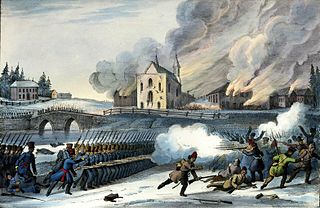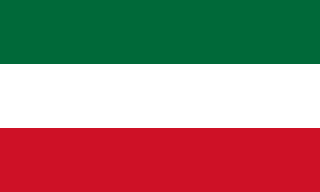
Louis-Joseph Papineau, born in Montreal, Quebec, was a politician, lawyer, and the landlord of the seigneurie de la Petite-Nation. He was the leader of the reformist Patriote movement before the Lower Canada Rebellion of 1837–1838. His father was Joseph Papineau, also a politician in Quebec. Papineau was the eldest of eight children and was the grandfather of the journalist Henri Bourassa, founder of the newspaper Le Devoir. Louis-Joseph Papineau is commemorated by a public artwork installed in the metro station, Papineau that serves the street named for his father Joseph Papineau. L'École Secondaire Louis-Joseph Papineau in Montreal was named after him.

The Lower Canada Rebellion, commonly referred to as the Patriots' War in French, is the name given to the armed conflict in 1837–38 between rebels and the colonial government of Lower Canada. Together with the simultaneous rebellion in the neighbouring colony of Upper Canada, it formed the Rebellions of 1837–38.
The Ninety-Two Resolutions were drafted by Louis-Joseph Papineau and other members of the Parti patriote of Lower Canada in 1834. The resolutions were a long series of demands for political reforms in the British-governed colony.

This section of the Timeline of Quebec history concerns the events in British North America relating to what is the present day province of Quebec, Canada between the time of the Constitutional Act of 1791 and the Act of Union 1840.
The British North America Act, 1840, also known as the Act of Union 1840, was approved by Parliament in July 1840 and proclaimed February 10, 1841, in Montreal. It abolished the legislatures of Lower Canada and Upper Canada and established a new political entity, the Province of Canada to replace them. The Act was similar in nature and in goals to the other Acts of Union enacted by the British Parliament.

Robert Nelson was an Anglo-Quebecer physician and a leading figure in the Lower Canada Rebellion in 19th century Quebec.

Wolfred Nelson was the mayor of Montreal, Quebec, from 1854 to 1856.

Events from the year 1837 in Canada.

The Parti canadien or Parti patriote was a primarily francophone political party in what is now Quebec founded by members of the liberal elite of Lower Canada at the beginning of the 19th century. Its members were made up of liberal professionals and small-scale merchants, including François Blanchet, Pierre-Stanislas Bédard, John Neilson, Jean-Thomas Taschereau, James Stuart, Louis Bourdages, Denis-Benjamin Viger, Daniel Tracey, Edmund Bailey O'Callaghan, Andrew Stuart and Louis-Joseph Papineau.

John Neilson was a Scots-Quebecer editor of the newspaper La Gazette de Québec/The Quebec Gazette and a politician.
The constitutional history of Canada begins with the 1763 Treaty of Paris, in which France ceded most of New France to Great Britain. Canada was the colony along the St Lawrence River, part of present-day Ontario and Quebec. Its government underwent many structural changes over the following century. In 1867 Canada became the name of the new federal Dominion extending ultimately from the Atlantic to the Pacific and the Arctic coasts. Canada obtained legislative autonomy from the United Kingdom in 1931, and had its constitution patriated in 1982. Canada's constitution includes the amalgam of constitutional law spanning this history.

The Battle of Saint-Denis was fought on November 23, 1837, between British colonial authorities under Lieutenant-Colonel Gore and Patriote rebels in Lower Canada as part of the Lower Canada Rebellion. The Patriotes were led by Wolfred Nelson. Gore was sent to quell the uprising in the Richelieu River valley in conjunction with a force led by Lieutenant-Colonel George Wetherall. Gore was the first to arrive at a Patriote-held site. Nelson had organized the defence with most of the well-armed rebels within a stone house that overlooked the road. Gore, accompanied by only one cannon, attempted to take the stone house three times, with the cannon providing ineffective fire. Another attempt to flank the house to the left failed when Gore's soldiers encountered the less well-armed militia. Running out of ammunition, the British retreated. This marked the only Patriote victory in 1837, as this battle was followed by two defeats at Saint-Charles and Saint-Eustache.

The Assembly of the Six Counties was an assembly of Patriote leaders and approximately 6,000 followers held in Saint-Charles, Lower Canada on October 23 and October 24, 1837, despite the June 15 Proclamation of the government forbidding public assemblies.

The Patriote popular assemblies gathered supporters and leaders of the Patriote movement and the Parti patriote in 1837 Lower Canada. The assemblies, concentrated in the Montreal and Montérégie region, saw votes on resolutions and speeches of some of Lower Canada's most reputed orators.

L'Assemblée des six-comtés, also known as Manifestation des Canadiens contre le gouvernement anglais, à Saint-Charles, en 1837, is a large oil painting executed on canvas by Ontario artist Charles Alexander Smith in 1890.

The Republic of Lower Canada was a break-away state proclaimed in the aftermath of the 1837 Rebellions. The defeat of the rebellion meant that the state could never be properly established.

The Patriote flag was utilised by the Patriote movement in Lower Canada between 1832 and 1838.
Cyrille-Hector-Octave Côté was a physician and political figure in Lower Canada.
The following is an incomplete bibliography of the 1837-1838 insurrections in Lower Canada in the English and French languages, by publication date and document type.











